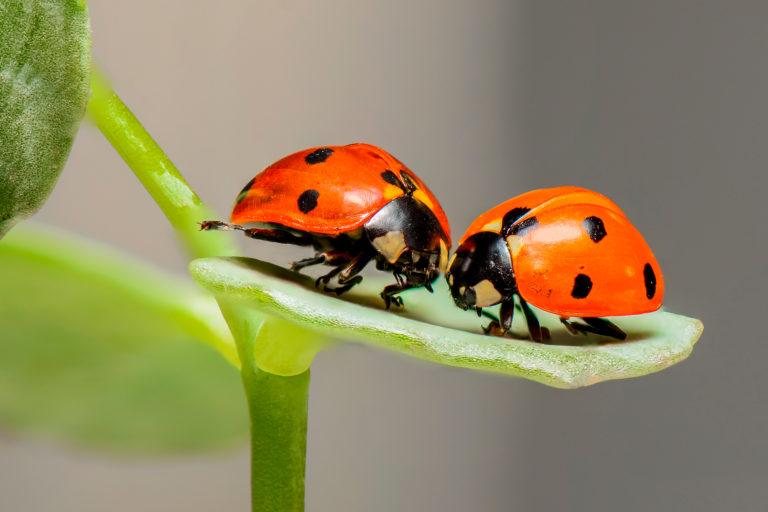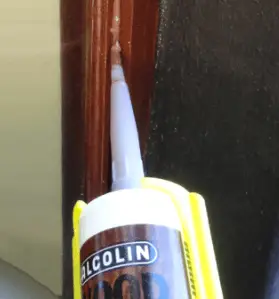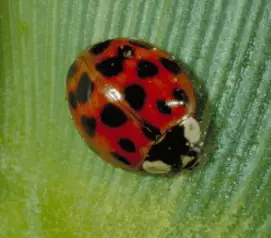
It’s true that the ladybugs (or ladybirds, if you’re from across the pond) you want to get rid of aren’t actually lady bugs. Well, they are, and they aren’t. Most of the problems you’re seeing with migration of ladybugs indoors aren’t caused by the native species of ladybugs in your area (though there are those). Most ladybug problems and infestations are caused by the multicolored Asian lady beetle, imported by the government to help reduce the populations of tree-killing aphids. Like may well-intentioned programs, the Asian lady beetle experiment did not go terribly well.
A lot of people harbor the misconception that lady bugs and Asian beetles are pests, or that the Asian beetle is a pest and the ladybug is not. The truth is, neither beetle is a pest; they both feed on aphids, which, if you’re a gardener, you know are one of the most common and most harmful garden pests. Ladybugs and Asian beetles eat aphids. In fact, some gardeners actually have bags of ladybugs shipped to them so they can do a controlled release.
Nevertheless you came here to get rid of ladybugs. Though you can’t ever get rid of ladybugs or get rid of Asian beetles, there are some things you can do to control their migration indoors and their populations outdoors.
Asian Lady Beetles vs. Native Ladybugs?
There isn’t much of a difference. True, they’re all a different species of insect, but their life cycles and their predatory natures are much the same. Both ladybugs and Asian lady beetles eat aphids and a multitude of different crop-killing insects and mites. Both the Asian lady beetle and the American ladybug are considered tremendously beneficial insects for agricultural purposes. Several beetles were brought to America because they tended to eat aphids that fed on trees, rather than crops and garden vegetation.
Asian beetles tend to come out in the fall, and similar to the boxelder bug, invade for just a few weeks but in very large numbers. Then they are gone for a while, and return in the spring.
The biggest differences between the two is that an Asian lady beetle has an “M” marking on the back of its head, about where its neck would be if it was a mammal. In addition, Asian lady beetles are much more invasive than ladybugs, which tend to live in better harmony with nature.
This article focuses on ladybugs, but in reality, the two are pretty similar if you are trying to get rid of them.!
Best Ways to Get Rid of Ladybugs
Screen doors, window screens, and screened in porches should be inspected and properly sealed if you want to get rid of ladybugs.
Perhaps the most common way for ladybugs to get into your home is through a crack in your screen windows or through a screen door that doesn’t properly fit the frame it’s resting in. In this sense, ladybugs get in the exact same way other bugs and grubs do, through a small, tiny gap. Our piece on how to get rid of centipedes, for example, gives very similar advice.
It doesn’t take much of a crack at all to have ladybugs sneak into your home. In fact, relatively new houses that are well-sealed can get ladybugs. If you find ladybugs coming in through your windows or door seals, don’t assume that it is because of a construction flaw — these little beetles are just that good!
Weather stripping is probably the cheapest way to seal screen doors, while a torn window screen will probably require a new screen. Luckily for you, screening is cheap if you choose to repair it yourself, and standard-sized window screens are cheap if DIY window repair isn’t your cup of tea.
Although given the fact you can replace a window screen with a $4 tool, $5 worth of screen, like this one on Amazon, and a bit of time, it’s silly not to give it an attempt.
Don’t forget skylights! Skylights are much more difficult to inspect and maintain. As a result, they tend to have deferred maintenance and gaps that result in bugs getting in.

Door frames, window frames, and siding is the next thing you’ll want to seal to get rid of ladybugs.
Some ladybugs are just too stubborn to take the easy way indoors, and instead they will try to get in through the siding of your house. Either inspect and seal the siding yourself, making sure to seal siding that surrounds things like air vents and piping, or have a professional siding company come in and do the job for you.
Either way, preventing the migration of Asian beetles and ladybugs indoors requires that you bar any entrance from outside into your home. You may even want to consider temporarily blocking your roof vents when the weather starts to get colder.
The tiniest of gaps can cause ladybugs to find their way into the cavity around a window or door. A good idea each spring is to seal around any windows and door frames. Gorilla sells a good, all-purpose sealer (here on Amazon) that works in most situations.
Landscaping professionals have noted that lining the immediate perimeter of your house with food grade diatomaceous earth will get rid of ladybugs.
Diatomaceous earth is a natural pest deterrent that I’ve been pushing in my articles for quite some time. It comes from fossilized algae that are mined and then eithe refined for medical purposes or bagged for landscaping and pest control needs. The most popular theory regarding diatomite’s effectiveness suggests that it is the microscopically, razor sharp composition of the algae that cut through the exoskeleton of the intruding insect, causing death by dehydration. This strategy of lining the sides of your house with this sediment with diatomaceous earth has been recommended to help control earwig populations, and I would recommend it as a possible way to control ladybug populations as well.

A long-lasting pesticide or insecticide can help prevent ladybug migration.
We get it. Not everyone is a fan of using pesticides or insecticides. In fact, we avoid using them whenever we can. But there are some situations when a pesticide is perhaps the most sure and definitive answer to a pest outbreak.
Cornell University suggests that such a pesticide (usually a pyrethrin or pyrethroid) be applied to outside walls and siding, as well as around eaves, attic vents, roof overhangs, and doors and windows. Pyrethrin is one of the most commonly used insectides on the market today, and the variants of it (called pyrethroids) are abundant as well. Usually this is mixed with a carrier substrate which acts as a light adhesive, binding the pyrethrin to the surface it is sprayed upon. Ladybugs that come into contact with the substance die shortly afterwards.
Pesticides usually work best on active ladybugs. They generally don’t work on overwintering ladybugs that are harder to get at, and not quite as active.
The Ohio State University Extension office also offers a quick and effective way to control ladybug populations indoors as well.
I found this trick to be particularly clever. What you do is take the hose to your vacuum and stick a nylon down it, and sealing the nylon to the vacuum hose with a rubber band. What you’ve done, essentially, is to create a filter on the end of your vacuum hose. Then all you do is go around the house on a particularly “fruitful” day for ladybug migration and vacuum them up. They get trapped in the nylon, which is then removed, tied, and throw in the garbage–or you can empty the nylon somewhere far away from your home. This is probably the most effective and least ecologically destructive way to get rid of ladybugs.
This technique actually works great on boxelder bugs, too.
Since all of the hype surrounding the spike in the populations of asian beetles (multicolored asian lady bugs) started, a lot of companies have popped up claiming that they have the perfect ladybug control. I can’t advise you to purchase any of these products because I’ve never used them.
Ladybug control in the spring and fall is a lot like boxelder bug control; there is no certain poison designed specifically to kill either pest. Some pest control professionals recommend using ladybug traps in what is called a “push and pull” strategy. Essentially, a toxic chemical is used to push the ladybugs out of the places where they’re hiding and a trap filled with ladybug attractants (usually sold with the ladybug trap) are then used to remove the ladybug.
I assume that this strategy would work from a logical stand point, but again, I’ve never tried it. Though perhaps I’ll purchase a trap for use this spring. Until then, if you want to try some of the ladybug control devices offered, please let me know how they work. I may use your testimonials in a subsequent update of how to get rid of ladybugs.
Best Natural Ladybug Control Methods
Food Grade Diatomaceous Earth.
As I mention in the main text of how to get rid of ladybugs, diatomaceous earth is a perfectly natural substitute for pyrethrins, particularly those that are dusted into crevices or sprayed on the ground to control ladybug populations. If ladybugs really aren’t your cup of tea, you might want to consider using diatomaceous earth in more of your landscaping projects.You can order bags of it at Amazon.
Camphor & Menthol are apparently very good ladybug repellents.
According to a study cited by OSU, ladybugs and asian beetles are extremely sensitive to camphor and menthol vapors. This is good news for those of us with massive infestations; misting those areas where ladybugs are thought to be overwintering may drive them out of their hiding areas where they can be captured.
Soap & Water Traps
Since ladybugs tend to be driven toward light when they come out of their hiding places in our homes, instead of letting them sit by the window and fly away when it gets dark, why not put a bowl of water with a dab of soap next to lamps and windows? The drop of soap kills water tension (which bugs rely on to escape when they come into contact with water) and when bugs come into contact with the solution they drown rather than float. It’s worth a shot, right?
Boric Acid.
Otherwise known as Borax, boric acid has been used as a natural pesticide for quite some time and its application is similar to that of pyrethrins and/or pyrethroids. It is dusted into hard to reach places, or areas where ladybugs and other pests like cockroaches are thought to be hiding. Contact with the substance is necessary in order to kill the invading ladybug, so apply this powder where ever you’re certain they will tread on it. You can get Boric Acid powder from Amazon.
Ladybug FAQs
Do Ladybugs Hibernate?
Yes. Each fall, ladybugs start scouting for good places to spend the winter. They usually look for well-protected areas like piles of junk, trees that have crevices or loose bark, and yes, your house. When it comes to your house, they usually find a seam where they can sneak into the siding or roof, and hang out completely unnoticed by you. This is why it is so important to seal your house up.
They usually congregate with many other bugs, hunker down, and take a nice long nap for the winter.
Then, the first day in the spring when it starts to warm up and you notice a good warm sun hitting your house, you might see ladybug activity.
Do Ladybugs Bite?
Most ladybugs are completely harmless. The ladybugs that you and I probably grew up with, the native variety, don’t bite. They are actually quite nice.
As mentioned earlier, though, there are many bugs that are mistaken for or included in the umbrella of ladybugs. Asian lady beetles (we discussed them earlier) can bite. They don’t have venom, but they can give you a little pinch if they land on you.
Do Ladybugs Hurt Plants or Fruit?
No, ladybugs might nibble on a piece of fruit or a plant in your garden, but they really can’t make a dent in it or harm the health of the plant.
In fact, most ladybugs are beneficial for plants, because they eat the more harmful insects that are known risks for your garden or plants.
On balance, ladybugs are probably garden helpers because of their ability to eat the pests that are going after the stuff you are trying to grow.
Where do Ladybugs Live?
Everywhere.
The only place in North America that is not in ladybug range is the Northern 1/3 of Canada and Alaska, areas that are pretty sparsely populated. They are hardy creatures, and in the lower 48 of the USA and most of Europe, ladybugs are common.
There are, after all, 6,000 types of ladybugs, so one of them is bound to be able to survive in your backyard.